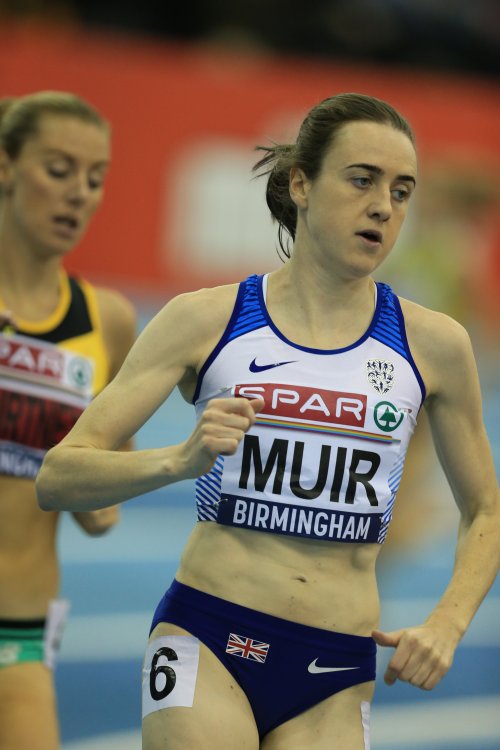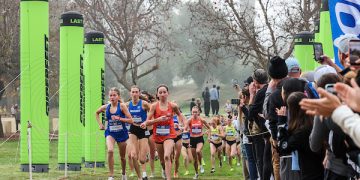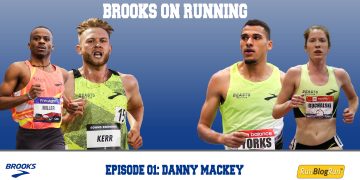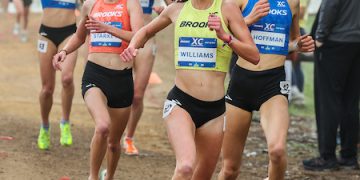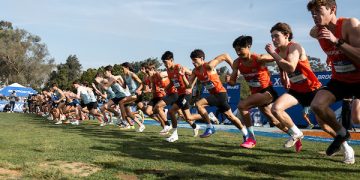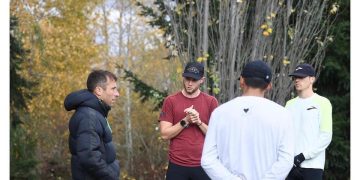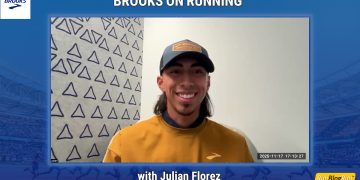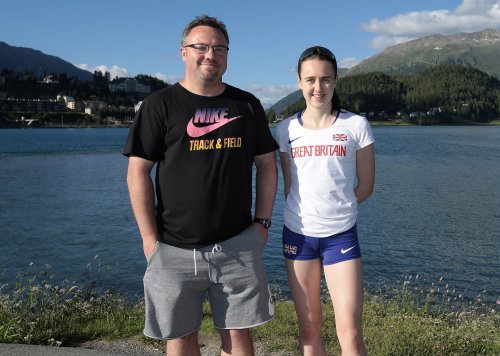 Andy Young and Laura Muir, photo by British Athletics
Andy Young and Laura Muir, photo by British Athletics
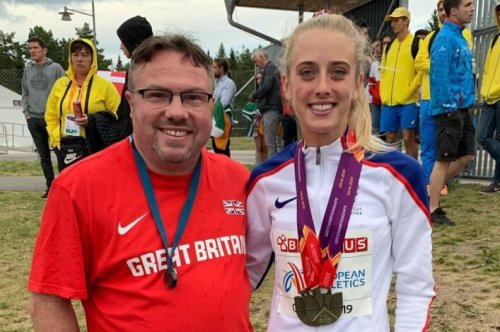 Andy Young and Jemma Reekie, photo by Scottish Athletics
Andy Young and Jemma Reekie, photo by Scottish Athletics
RelatedPosts
Andy Young Part 4 – Laura Muir and Jemma Reekie
How did you start working with Laura?
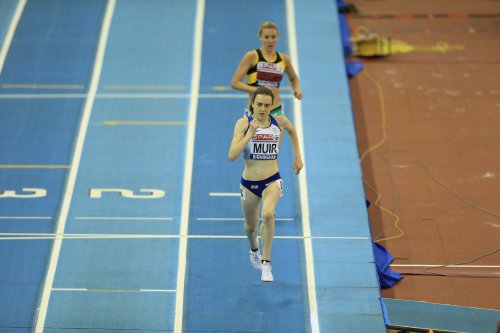 Laura Muir, photo by British Athletics
Laura Muir, photo by British Athletics
In 2011 she came to Glasgow University. She had won medals in Scottish schools and was quite a serious trainer but I don’t think she had any great interest in becoming an elite runner. A coach rang me and said an athlete was coming to university and would I keep an eye on her. That athlete and Laura started at the same time they were probably of similar level but the other one probably better than Laura. They started training together and very quickly I could see that beyond talent there was something about Laura. She had a fire in her. If we did a track session Laura would always be chasing the person in front. And when she caught them it would be the next person – often a boy. I was only taking the university club two or three times a week but Laura expressed an interest in taking it more seriously. So, I started working more with her, giving her a weekly schedule and introducing some strength and conditioning. She made progress very quickly, starting in September but by about November she had qualified for the Eurocross. Then she started breaking Scottish age group records indoors. Her 1500m PB dropped by about 20 seconds and she made the World Juniors that summer [2012].
Who runs Laura’s life – coach, agent, Scottish Athletics, British Athletics?
Every one of those has got a part. I’m not going to break it down. I try to take as much as possible off Laura’s plate. If you look at elite performers in sport, music etc, they don’t seem to fall out of love with their sport; it’s all the things that are roundabout that begin to weigh down and ruin it for them. So, I want Laura – and the others – to keep running for as many years as they can and to enjoy it, because if you enjoy it, you want to keep doing it. If I can keep the other requirements away from them as much as possible and allow them to do the bit that they enjoy, hopefully that will allow them to stay in it a bit longer.
During the first few years with Laura, she was doing a veterinary degree and Glasgow is famous for its medicine and veterinary studies. Sometimes, I hear people saying that Laura is an inspiration, showing that you can become a vet and one of the best athletes in the world. But I want to say it’s not really accurate. You can do both if you work really hard – every hour of the day – and if you have someone else doing everything for you, organizing not just your running but other aspects of your life like your finances. Because all you have time to do, is your studies and run. She is great inspiration but you’ve only got half the story. But it categorically would not have been possible without someone to organize the other half of her life – which I was happy to do. It worked well.
It’s changed a bit now that she has graduated but for that period, I was making all the decisions.
What is your assessment of Laura in Doha 2019 [Fifth in 3:55.76]?
Remarkable. She was in great shape in London when she won the Anniversary Games – though she will tell you that she was running on one leg for the last 300m. That was the 57 second last lap or whatever it was. Then the next two and a bit months were full of challenges and really difficult. So, after that to come out and run 3:55.76 – it takes your breath away, that you could run under 3:56, be inside the previous championship record and not medal. And it wasn’t far from a medal. But add to that, doing it on the back of the previous two months makes it more remarkable.
Were you surprised how quickly Jemma developed?
Yes and no! It’s always been a long-term project. The same with Laura. I always saw the potential and I could’ve pushed a lot harder and made her run a lot faster a lot younger. But I didn’t want to push her too far too quick and thereby risk injury or a breakdown. So, with Jemma, she had been European junior champion three years ago [European Under 20, 2017, 1500m in 4:13.25] . She had won that and last year she had done the double at the European Under 23s. And over the past year and a bit I’d seen further strides forward in training. But if you look at Jemma’s technique four years ago, with nothing going in the direction it should be going in! No forward momentum. So there was always potential for great progress if she could improve her technique. We’ve already improved it a lot. But it’s always been a gradual, long-term project but that was accelerated in the past 15 months. She’s become a lot more muscular and stronger. And some other significant things have happened, like discovering that she’s gluten intolerant. Also, she was having real problems with are sinuses; she was always getting ill and it would last for 5-6 weeks. So, she was losing huge amounts of training. She had a sinus operation in December and when they did the operation they found the blockages were much worse than they had anticipated. But over the past year or so, she has been so much healthier. That has led to big leaps forward in training.
For her to run sub two for 800m didn’t surprise me; I saw that coming. It almost have done that last summer. And then to run 1500m in four minutes at the Millrose Games. Jemma was in great shape in Doha but just didn’t get it right [10th prelim in in 4:12.51]. People think it was a long season for her and had a busy season but actually when it came to October she was in great shape. But it was her first World Championship and she is very young. She just didn’t get it right on the day. Now being healthier and being able to breathe is a big help!
But to run 1:57 [1:57.91 Glasgow, 1 February 2020] and the fastest time in the world for 15 years did surprise me. I’ll give you that. I didn’t see that coming so quickly. And then to run 1500m [4:00.52 at the Millrose Games, 8 February 2020] in a time faster than Laura and Kelly Holmes in the space of about 7 days. I didn’t see that coming. And to see her finish it off by winning the Glasgow Grand Prix. Probably by then I wasn’t as surprised but it was great to see her against a high-quality field, finding her feet. To see her doing what Laura had done in was 2014, making a big breakthrough. When these performances come, I tend to see them in training first but that 1:57 caught even me by surprise; it was a marvelous performance.
How has covid affected you?
There have been parts of this year that have been challenging. I mentioned how much I enjoyed the travelling and competitions and that was all removed. I was looking forward to some of the altitude training trips and they were canceled. I love the racing season and that’s been on hold until the beginning of August. For the athletes, Jemma really likes going on the camps but Laura enjoys being at home. But while Laura enjoys being at home, that she couldn’t see her family took the edge off it. And the athletes like to race and that was gone – and the targets were gone. Equally it was very difficult for me to plan.
Finally (mid-July) we went away on a camp at Font Romeu and is a nice to be back up in the mountains with some normality and to be preparing for races as opposed to the difficult three months we had. We were due to fly to Font Romeu earlier in the year. It was within 24 hours when they started canceling flights but at least we got there. Then we started racing.
Author
-

Since 2015, Stuart Weir has written for RunBlogRun. He attends about 20 events a year including all most global championships and Diamond Leagues. He enjoys finding the quirky and obscure story.
View all posts


